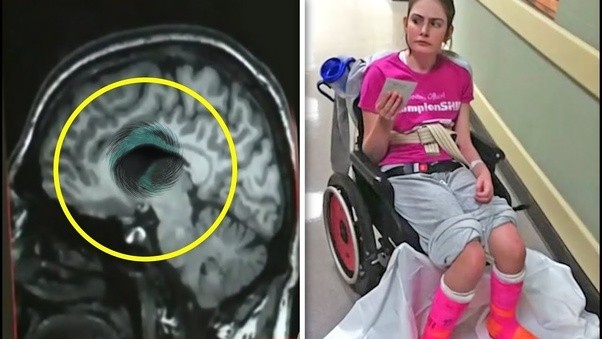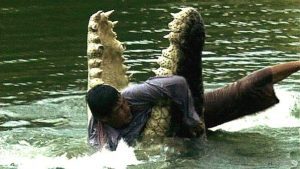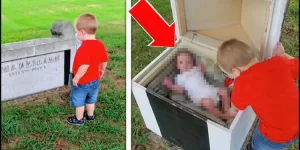A doctor initially thought she was suffering from a migraine, but a brain scan revealed something much worse. Like many people in the world, Andy Pullo suffered a few headaches when she was in her early teens. Similarly, she didn’t seem to think they were anything unusual. However, one day, almost entirely out of the blue, Andy became catatonic. It would be months before she would become responsive again.
It all happened very suddenly one January evening back in 2011, on the way back home from swim practice. Andy complained that she didn’t feel well. Shockingly, by the time she and her mom, Lynn, had arrived home, Andy couldn’t talk or walk. Of course, Lynn immediately contacted her pediatrician. At the time, the doctor was confident that this was nothing more serious than a migraine, but he referred Andy to the hospital for a checkup nonetheless. It was just as well, too, because that’s when they all learned that it was, in fact, something far more serious. The tests concluded that Andy had a rare brain defect from birth called an Arterial Venous Malformation (AVM).
This means that the veins and arteries in her brain were weakly connected, and that January night, one of those connections ruptured. In fact, Andy wasn’t just suffering from a migraine; she was having a stroke at just 14 years of age. “I knew it was bad when I walked into the operating room,” her dad, John, told MCT News Service. Andy had been rushed into surgery so that the doctors could insert an external drain and remove the blood that was pooling between her brain and her skull. “Being in that OR room with Andy being ventilated and all really hit me hard,” John added. Of course, the procedure was necessary. After all, if left untreated, the bleeding could have built up pressure that may have bruised the brain or worse, caused another stroke, one that might have permanently disabled or even killed Andy.
But even with rapid and successful treatment, the young teenager had years of recovery in front of her. Prior to the incident, Andy had been active in sports and was at the top of her class in grades. She was an 8th grader at Atlanta’s Holy Innocence Episcopal School, where she had attended since preschool. She loved swimming, softball, singing, and shopping. Now, however, Andy was fighting for her life. After the bleed was drained, Andy’s condition was monitored overnight. Then, two days later, she was transferred to another hospital where she underwent surgery for six hours before spending more than a month in intensive care.
During all this time, Andy relied on doctors and machines for everything, including helping her breathe. Indeed, the injury left Andy unable to move, talk, or eat on her own. And while she did master breathing on her own by April, she would need years of physiotherapy for the rest of the activities that most people take for granted. Not only were her physical limitations holding Andy back, but her personality also seemed to have changed too. In fact, the once outgoing and friendly young lady suddenly didn’t seem to want anyone near her. “She was resisting anybody being in her space,” her dad told Shepherd Center.
Though progress was slow, Andy eventually was released from the hospital care to return home and continue physical therapy there. But instead of getting better, Andy only got worse. So in June 2011, a hospital in Houston offered to treat Andy with behavioral therapy as well as the traditional rehab she’d been receiving for the next five months. Then, Andy’s parents would take turns visiting their daughter in Houston and looking after their seven-year-old son, George. Then after trying their hand in Houston, Andy’s parents found out about even more specialized help in Boston.
So from April to June 2012, John and Lynn again took turns commuting, and Andy received therapeutic treatments that included magnetic brain stimulation. Finally, in June 2012, a year and a half after her stroke, Andy began to nod her head and respond vocally. She wasn’t talking or crying, maybe screaming, but no tears or facial expressions. “I’m just trying to figure out if you understand me. What’s one plus one?” Lynn recalled. The questions got harder, but the answers still came.
And so, the long struggle to bring their daughter back began to show promise. It wasn’t always easy, but when the going was tough, nurses reminded Andy of her ultimate goal: to return to school. Indeed, Andy had turned a corner; her learning progress improved rapidly, and she was able to return to school in the fall of 2013. Fortunately, Andy herself has no recollection of her illness or rehabilitation. “I just felt like I had kind of been asleep for a long time, and then I woke up almost two and a half years later,” she told Children’s Healthcare of Atlanta.
What’s more, while Andy was going through rehabilitation, her friends wanted to do something to help her. So they formed what they called “Andy’s Army” and attempted to raise money to help her family pay for her hospital bills. Today, though the goals of the group have changed, it states that with the same steadfast resolve as Andy, the group works to identify and help families of children with non-traumatic brain injuries in need of financial assistance. In fact, Andy’s Army has, as of 2016, raised around 1.3 million dollars through charity runs, bake sales, and other fundraising events.
Recently, meanwhile, Andy herself was awarded recognition as one of four Atlanta Braves Community Heroes honorees. “Doctors told us she’d never walk again or talk again or go to school again. Now she’s a straight-A student,” her dad recalled. In fact, Andy is starting her senior year in high school and expects to go to college after graduation, a feat that seemed all but impossible just a few years ago.





